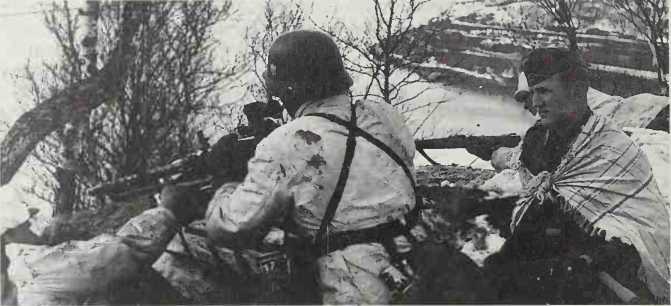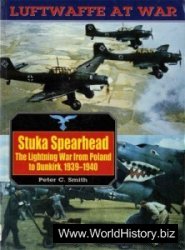North Kalimantan National Army (tenteha nasionai. Kalimantan UTAKA Itnku]) see hkunei
REVOLT.
North Korean People’s Army (NKPA). Originated in the national security forces created by the North Korean Interim People’s Committee in 1946. These forces, organized by Choe Yong Gon, became the nucleus of an army which grew to 100,000 men when the DPRK emerged in 1948 and Soviet troops withdrew. The nkpa was structured on the Soviet model with manpower concentrated in the combat units and was trained by Soviet advisers. Before the Korean War began in June 1950, it was strengthened by 150 Soviet tanks and the return of Korean veterans who had been fighting in the Chinese Civil War. On June 25
1950 the NKPA crossed the 38th Parallel with the main weight of the attack directed towards Seoul. The NKPA was not fully mobilized, deploying 38,000 men in the initial attack, suggesting that either the North Koreans expected a quick victory or that the offensive had been launched earlier than planned. When the US intervened, the NKPA hastily mobilized additional divisions. Although outnumbered and outgunned by August 1950, the NKPA fought with skill and fanaticism, creating a crisis on the Pusan Perimeter as late as September 1950. The Inchon landings dealt the nkpa a heavy blow but many troops continued to fight in the south as guerrillas or escaped into the northern mountains. The nkpa was reorganized with Soviet equipment after China entered the war in December 1950 and fought on the eastern sector of the front. In August-September
1951 it was involved in the heavy fighting around the Punchbowl at Bloody Ridge/Heartbreak Ridge. By the end of the war, total nkpa strength was approximately
257,000. CM.
Northrop F-5 (US). Single-seat/ two-seat lightweight fighter. Prototype flew July 30 1959; selected by US Department of Defense for supply to favoured nations (over 30) under Military Assistance Program, May 1962; these included Iran, which received 104 F-5As/RF-5As, 23 F-5Bs, 141
F-5Es, 28 F-5Fs; and South Vietnam, 172 F-5 As, 8 F-5Bs and about 48 F-5Es. Production 2,610, ended January 1987. Two 4,080/5,0001b (1,851-2,268kg) s. t. General Electric J85-GE-13/-21 engines; max. speed (F-5A) 898mph (l,445kph); two 20mm cannon, 6,2001b (2,812kg) external ordnance.
North Russian Expeditionary Force. The deteriorating situation in North Russia in the spring of 1918 led to the dispatch of British forces to protect Allied supplies and deter any German moves in the area. They became increasingly involved in operations against
¦ Bolshevik forces before their final evacuation from Murmansk in October 1919.
North Vietnamese Army see people’s ARMY OF VIETNAM (pAVN).
Northwest European campaign
(1944-45). Although the Allied bridgehead in Normandy was quickly secured, mounting German resistance frustrated attempts at achieving a breakout. The British Second Army’s Operation “Goodwood” soon degenerated into an attritional struggle for Caen while the Americans’ Operation “Cobra” was slow to develop. However Patton imparted a fresh impetus, attacking on August 1 and striking into Brittany before wheeling eastwards. A German counterattack against the bridgehead was frustrated and 50,000 troops were encircled and captured in the Argentan-Falaise gap. The success of the Allied breakout and the disarray of the German forces led Eisenhower to amend his plans and approve a rapid advance to the River Seine. On August 25 Paris was liberated; meanwhile on the 15th the Allies had landed in the South of France. On September 11 the Allied invasion forces met and Eisenhower had a continuous front from the Mediterranean to the Channel. While wishing to exert pressure along the length of the line, the Supreme Commander supported a thrust by Montgomery’s 21st Army Group into northern France and Belgium. On September 3 the British Second Army captured Brussels and the following day took Antwerp. As the Allies approached the German border, enemy resistance grew
More resolute. Furthermfire the rapidity of the advance had exhausted Allied manpower and resources. These factors helped convince Eisenhower to approve Operation “Market Garden”, that envisaged the seizure of the Rhine Crossings and a sweep into the Ruhr. Launched on September 17, the plan failed with ground troops unable to relieve airborne forces at Arnhem. Although the broad front policy was thus vindicated, a measured advance also entailed heavy fighting in the Vosges, the Htirl-gen Forest and the Saar. Allied fatigue and complacency proved costly when, on December 16, the Germans launched a counteroffensive in the Ardennes. Although with little chance of success, the strength of the attack surprised and disturbed the Allies. Insufficient men and material forced the Germans to retire and, by the end of January 1945, they had nothing to show for their 100,000 casualties and the loss of irreplaceable reserves of fuel and equipment. Furthermore, Hitler’s refusal to allow a retreat to the east bank of the Rhine resulted in additional losses. Ultimately, the Rhine failed to constitute a major defensive barrier, for on March 7, elements of the American 9th Armored Division were able to establish the first Allied bridgehead across the river, securing the Ludendorff bridge at Remagen while German army engineers were in the very act of demolishing it. However, the main Allied effort came on the 23rd with Operation “Plunder”, the 21st Army Group’s assault across the Rhine. By April 18 the Ruhr “pocket” had been encircled, eliminating 325,000 German troops, and Allied forces streamed into Germany, encountering both fanatical resistance and peaceful capitulation. American, French and British units fanned out into southern Germany, Austria, Czechoslovakia and Italy and on April 25 1945 contact was made with Soviet ground forces. Finally on May 4 Montgomery received the formal surrender of German forces in the north while Gen Devers accepted the capitulation of those in the south. The formal conclusion of hostilities occurred on May 7 1945 with a surrender ceremony concluded at Reims. MS.

German machine gun team (with Norwegian prisoner) in action near Narvik, 1940
Norway, German invasion of
(April 2-9 1940). The plan depended on surprise, which was successfully achieved. Equipment carrying merchantmen, disguised as coal ships, left German ports on April 2, followed on the 6th by six naval task forces, transporting the leading elements of the German occupation forces for Oslo, Kris-tiansand, Egersund, Bergen, Trondheim and Narvik. They were assisted by parachute drops on important Norwegian airfields, and air-landing of reinforcements. Two-thirds of the German submarine fleet was deployed to protect them. The winter weather fortuitously helped - fog and low cloud blinding Allied air reconnaissance, and high seas in the North Sea slowing the British Home Fleet which failed to intercept through faulty intelligence.
All objectives were taken against sporadic Norwegian resistance. German naval losses were significant: cruiser Blucher was sunk and pocket battleship LiXtzow damaged by the guns of the Oslo forts; cruiser Karlsruhe was sunk by the British submarine Truant off Kristiansand; the cruiser Konigsberg was damaged by fire from the forts at Bergen on April 9, then sunk by Skua dive-bombers next day (usually accepted as the first sinking of a major warship by dive-bombers); cruiser Hipper was rammed and damaged by the British destroyer Glowworm off Trondheim; battlecruiser Gneisenau was hit twice and badly damaged by Renown off Narvik; battlecruiser Scharnhorst suffered torpedo damage and some ten equipment-carrying merchant ships were sunk. WGFJ.
Norwegian campaign (April 8-June 8 1940). During the winter of
1939-40, both Allied and German High Commands drew up contingency plans to invade Norway. In September 1939, the Allies planned to mine Norwegian territorial waters - the Leads - to stop the flow of Swedish iron ore from Narvik to Germany. By December, the plan included a landing at Narvik, and an advance inland to occupy the iron ore mines in the Kiruna-Gallivare district of northern Sweden, close to the Finnish frontier. Landings at Stavanger, Bergen and Trondheim would forestall German countermeasures.
Occupation of Norway was not included in Germany’s original war plans. However, Hitler, advised by Adm Raeder, decided in December 1939 that there would be advantage in occupying Denmark and Norway to secure submarine and air bases from which to outflank the British naval blockade, while protecting supplies of Swedish iron ore, vital to German armament production. Hitler considered engineering a coup d’etat led by the pro-Nazi Vidkun Quisling, but, doubting the strength of Quisling’s support, opted for a military solution. Gen von Falkenhorst was appointed to plan and command a joint naval, land and air operation, deploying six divisions (including the specially trained and equipped 3rd Mountain Division, commanded by Gen Dietl. The leading elements of the invasion forces were to be transported and covered by the whole German Navy, and supported by over 1,000 aircraft.
Neither side was prepared to infringe Scandinavian neutrality without a good excuse. The Russian invasion of Finland in November 1939 gave the Allies a pretext for intervention, but their plans collapsed when the Finns accepted Russian armistice terms on March 12 1940. The Allies revived their invasion plans on March 28 1940 in order to bring greater economic pressure to bear on Germany. Mining of the Leads was to start on April 5. They made two grave errors of judgment: first, they assumed that the Germans would not risk their fleet in the face of British naval superiority; and, secondly, they underestimated the crippling effects of German air superiority.
Hitler struck first: in a superbly coordinated operation, Copenhagen, Oslo, Kristiansand, Egersund, Stavanger, Bergen, Trondheim and Narvik were all occupied by April 9. German naval losses were heavy, but their troops held all the Allies’ proposed objectives.
The Allies’ reaction was fumbling and piecemeal. As soon as the German Fleet was known to be at sea, the British Home Fleet (Adm Forbes) disembarked all troops already loaded for the proposed occupation of Stavanger, Bergen and Trondheim, and sailed to intercept, but was too late. Five of six German naval task forces had landed their troops and returned to Germany, but ten destroyers of the sixth were destroyed in the Narvik fjords on April 10-13.
On April 10, the Allies decided to concentrate on the capture of Narvik, placing naval forces under Adm of the Fleet, the Earl of Cork and Orrery, and two British infantry brigades (one regular and one territorial) under Maj Gen Mack-esy (1883-1956), Commander 49th Division. The troops started to land on April 14 at Harstad, on an island 60 miles (96km) west of Narvik, which was to be developed as an advanced base for an attack on the port, and an advance to the Swedish iron ore mines. The Admiral wanted to attack at once while the Germans were disorganized after the second naval engagement, but Mackesy deemed it impractical to do so without landing craft, and in the prevailing bad weather.




 World History
World History









